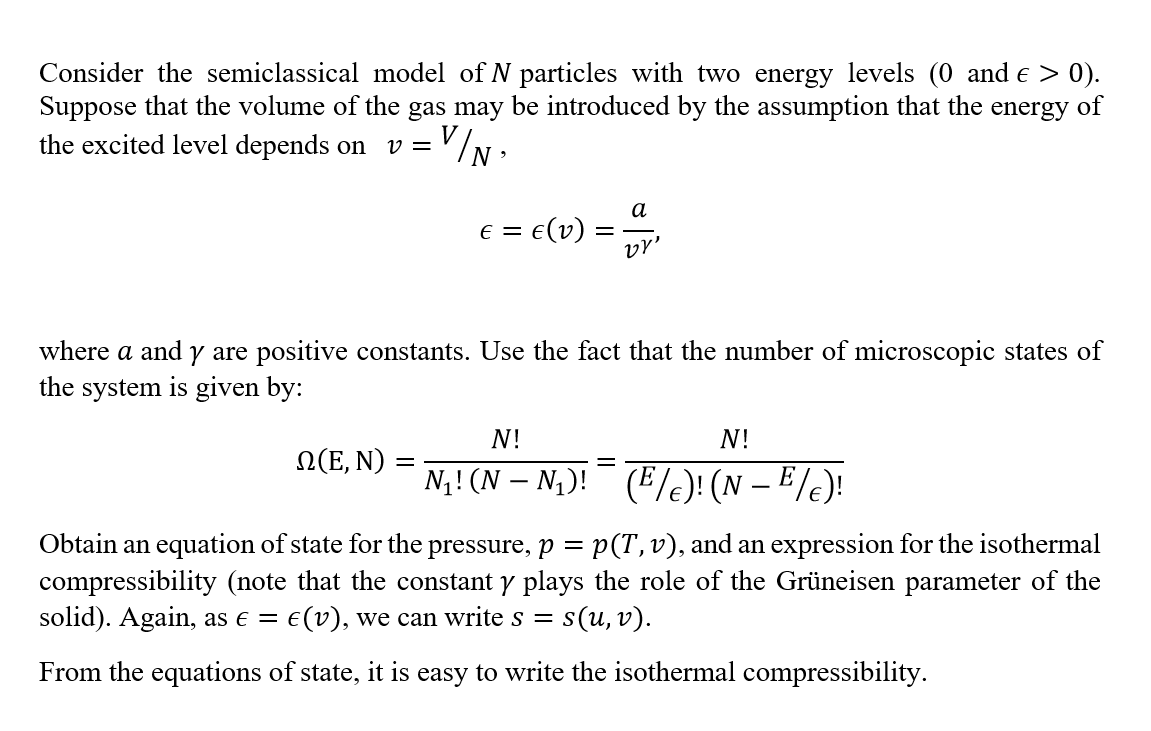Consider the semiclassical model of N particles with two energy levels (0 and e > 0). Suppose that the volume of the gas may be introduced by the assumption that the energy of the excited level depends on V = a e = e(v) vr' E = where a and y are positive constants. Use the fact that the number of microscopic states of the system is given by: N! N! N(E, N) : N4! (N – N,)! (E/e)! (N – E /e)! Obtain an equation of state for the pressure, p = p(T,v), and an expression for the isothermal compressibility (note that the constant y plays the role of the Grüneisen parameter of the solid). Again, as e = :E(v), we can write s = s(u, v). From the equations of state, it is easy to write the isothermal compressibility.
Consider the semiclassical model of N particles with two energy levels (0 and e > 0). Suppose that the volume of the gas may be introduced by the assumption that the energy of the excited level depends on V = a e = e(v) vr' E = where a and y are positive constants. Use the fact that the number of microscopic states of the system is given by: N! N! N(E, N) : N4! (N – N,)! (E/e)! (N – E /e)! Obtain an equation of state for the pressure, p = p(T,v), and an expression for the isothermal compressibility (note that the constant y plays the role of the Grüneisen parameter of the solid). Again, as e = :E(v), we can write s = s(u, v). From the equations of state, it is easy to write the isothermal compressibility.
Modern Physics
3rd Edition
ISBN:9781111794378
Author:Raymond A. Serway, Clement J. Moses, Curt A. Moyer
Publisher:Raymond A. Serway, Clement J. Moses, Curt A. Moyer
Chapter7: Tunneling Phenomena
Section: Chapter Questions
Problem 16P
Related questions
Question
Please don´t answer by partition equation!

Transcribed Image Text:Consider the semiclassical model of N particles with two energy levels (0 and e > 0).
Suppose that the volume of the gas may be introduced by the assumption that the energy of
the excited level depends on
V =
a
e = e(v)
vr'
E =
where a and y are positive constants. Use the fact that the number of microscopic states of
the system is given by:
N!
N!
N(E, N) :
N4! (N – N,)! (E/e)! (N – E /e)!
Obtain an equation of state for the pressure, p = p(T,v), and an expression for the isothermal
compressibility (note that the constant y plays the role of the Grüneisen parameter of the
solid). Again, as e =
:E(v), we can write s =
s(u, v).
From the equations of state, it is easy to write the isothermal compressibility.
Expert Solution
This question has been solved!
Explore an expertly crafted, step-by-step solution for a thorough understanding of key concepts.
Step by step
Solved in 2 steps with 2 images

Recommended textbooks for you

Modern Physics
Physics
ISBN:
9781111794378
Author:
Raymond A. Serway, Clement J. Moses, Curt A. Moyer
Publisher:
Cengage Learning

Principles of Physics: A Calculus-Based Text
Physics
ISBN:
9781133104261
Author:
Raymond A. Serway, John W. Jewett
Publisher:
Cengage Learning

Physics for Scientists and Engineers with Modern …
Physics
ISBN:
9781337553292
Author:
Raymond A. Serway, John W. Jewett
Publisher:
Cengage Learning

Modern Physics
Physics
ISBN:
9781111794378
Author:
Raymond A. Serway, Clement J. Moses, Curt A. Moyer
Publisher:
Cengage Learning

Principles of Physics: A Calculus-Based Text
Physics
ISBN:
9781133104261
Author:
Raymond A. Serway, John W. Jewett
Publisher:
Cengage Learning

Physics for Scientists and Engineers with Modern …
Physics
ISBN:
9781337553292
Author:
Raymond A. Serway, John W. Jewett
Publisher:
Cengage Learning

Classical Dynamics of Particles and Systems
Physics
ISBN:
9780534408961
Author:
Stephen T. Thornton, Jerry B. Marion
Publisher:
Cengage Learning

Physics for Scientists and Engineers: Foundations…
Physics
ISBN:
9781133939146
Author:
Katz, Debora M.
Publisher:
Cengage Learning